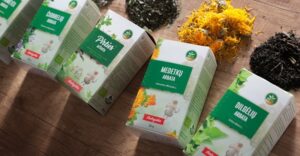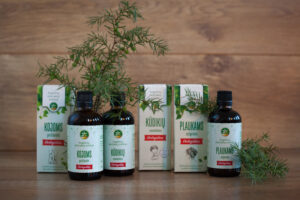o the highly trained nose of the perfume scientist, fragrances composed entirely of organic essences are little more than primitive offerings to the Goat God Pan. Indeed, they would argue, such ‘crude’ mixtures of essences may have tantalised and seduced the senses in former times, but the modern nose is much more discerning and sophisticated.
If the truth be known, most people would be surprised if they knew exactly what went into some of the big name perfumes. The beautiful bottles contain exotic cocktails of aroma chemicals with unromantic names like trimethylundecylenic aldehyde, isoamyl salicylate and terpineol extra. Unmodified essential oils hardly get a look in. Yet even though vou may be intoxicated by ‘ Opium’, beguiled by ‘Charlie’ and distracted by ‘Obsession’ this does not mean that you cannot rediscover the mystery and allure of perfumes in their natural state. But be warned: once weaned on to naturals, your senses will never be the same again. An expensive big name perfume whose aura once held you spellbound may now cause vour nose to twitch in disbelief, or in defence from chemical warfare!
If you are already enamoured of aromatherapy, creating perfumes using essential oils is a natural progression in your alchemical apprenticeship. You will be ready to delve a little deeper into the mysteries of creative blending, and to indulge in the scentsational art of seduction.
Essential oils notes
It was the nineteenth-century French perfumer Charles Piesse who categorised aromatic oils according to a scale of top, middle and base notes, corresponding to the notes on the musical stave. The top note of a blend is what you smell as soon as the fragrance begins to vaporise on your skin. It awakens and stimulates the senses. This quickly disappears to reveal the longer-lasting middle note. The base note is what you smell sometimes hours after the first application, when the top and middle notes have faded.

Some of the most popular top notes (also calte d ‘head’ notes) are bergamot, and lemon. These highly volatile essences add brightness and clarity to a blend, much like a flute adds high-pitched purity to an orchestra. The middle notes (sometimes called ‘heart’ notes) such as rose, vanilla and ylang ylang, impart warmth and fullness to the fragrant composition, rather like the mellow tone of the oboe. Then there are the heavy lingering base notes (also known as ‘bottom’ notes or the ‘dry out’). These include patchouli, frankincense, sandalwood and vetiver. Just like the hauntins voice of the cello, they have a profound influence on the blend as a whole. They are also good ‘fixatives’, which means they slow down the evaporation rate of the top and middle notes, thus improving the ‘staying power’ of the blend. Sandalwood is the base note which is regarded as one of the finest natural fixatives because its soft aroma harmonises as a background note to a wide variety of fragrant compositions.
However, as nature would have it, few essential oils resonate entirely from one of the three ranges; a reflection of their complex chemical nature. Most reach up or down to an adjacent Ievel (see the Perfume Notes chart on page 231). Thus they are able to link hands with the similarly friendly molecules of other essences. Oils which are especially good at linking with others are called ‘bridges’; they connect many individual components and allow them to merge into perfect accord. Rose otto could be described as the bridging note supreme, for although resonating mainly from the heart, it also embraces both head and base. Indeed, at one time no perfume (whether regarded as a feminine or masculine fragrance) was deemed complete without the addition of rose.
You may find it interesting to see if you can perceive ‘notes within notes’. Put a drop of essential oil on a piece of blotting paper or a purpose-designed smelling strip and try to experience the emerging nuances of aroma. Take geranium, for example; initially the scent is intensely sweet (almost honey-like), but stay with it a little longer and you may perceive an unexpected hint of mint, which gives way to a peppery rosy note and a sensation of ‘cold’. To take another example, the first hint of ylang ylang reveals a richly floral fragrance, but with a disconcerting tinge reminiscent of nail polish. Thankfully, the harsh element soon gives way to the pleasure of cream soda and almonds, drying out to reveal a jasmine-like undertone.
Adapting perfumes
Although the blending of essences for aesthetic purposes may seem more complicated than therapeutic blending, in practice your developing sense of smell will be your guide. Just as a good cook will check the flavour of a dish by tasting every so often and adjusting the seasoning accordingly, the kitchen alchemist builds a perfume step by step.

For example: should an aromatic concoction smell too garish, the top note being far removed from the middle note, the formula can be toned down by adding a tiny amount of an essence with a softer quality, yet at the same time one that vibrates from the middle towards the upper range. Lavender or clary sage would be a good choice. If, on the other hand, the base note has taken over, simply lift the aroma by adding an oil that smells a little brighter, resonating from middle to base: ylang ylang may suit. Should the base note still be predominant, try adding a single drop of a lighter, freshersmelling oil, one that will connect with the higher notes of ylang ylang. Bergamot may well be the essence required to bind the spell.
But your blends need not be so complex: cedarwood (base), clary sage (middle) and petitgrain (top) make an interesting ‘woodland’ blend. Or you may find that a certain aromatic oil smells wonderful just as it is. Oils such as carnation, jasmine, rose, ylang ylang, patchouli and sandalwood are often used as loners.
Yet not all perfumes conform to the traditional top, middle and base note pattern. Light, refreshing fragrances like classic eau-de-Cologne never contain heavy base notes, but are composed mainly of top notes. However, they are skilfully blended taking into account the ‘notes within notes’ theme. The highly volatile bergamot is the principal component of such blends; its purpose is to temper the evaporation rate of the even flightier essences of grapefruit, lemon, lime, orange or mandarin. Neroli, another popular ingredient of the highest quality eau-de-Cologne, has the same slight tempering effect on bergamot and other citrus essences. Add a touch of rosemary, which resonates within the middle range, and this acts to slow down the volatility rate of neroli as well as the citrus element of the blend.
But no matter how skilfully blended, a light-hearted eau-de-Cologne formula can never be more than a fleeting encounter, even when held in check with the addition of relatively powerful chemical fixatives (as is the case with commercial eaux-de-Cologne). Unless a blend contains one of the heavy lingerers like jasmine, patchouli or sandalwood (or a similarly heavy chemical fixative), once applied to the skin it will rarely last for more than a couple of hours. On the other hand a rich blend featuring the deeply resonating patchouli will waft its earthy fragrance for many hours; and when used to perfume clothing, for instance a heavy woollen coat, will continue to broadcast its presence for some months.
Perfume notes chart
As far as aromatherapy perfumes are concerned, harmonious blends can be composed entirely of middle notes or of base notes, or whatever permutation you can think of. But should you be determined to compose according to the rules, the following information will help.
| Top Notes | Top to Middle | Middle to Top | Middle Notes | Middle to Base | Base to Middle | Base Notes |
| („head“ notes) | („heart“ notes | (Also known as „bottom“ notes or „dry out“) | ||||
| Angelica | Angelica | Black pepper | Black pepper | Arnation absolute | Cedarwood | Cedarwood |
| Basil | Basil | Chamomile (Roman) | Cinnamon bark (room scent) | Cypress** | Frankinsece | Frankinsece |
| Bergamot | Bergamot | Chamomile (German) | Clary Sage | Elemi | Jasmine absolute | Oakmoss |
| Cardamom | Cajeput** | Clary Sage | Clove (room scent) | Galbanum* | Myrrh** | Patchouli |
| Coriander | Cardamom | Clove (room scent) | Galbanum* | Jasmin absolute | Oakmoss | Sandalwood |
| Eucalyptus** | Fennel* | Galbanum* | Geranium | Myrrh** | Sandalwood | Vetiver |
| Fennel | Geranium | Geranium | Ginger | Rose otto | ||
| Grapefruit | Lavender | Juniper berry | Juniper berry | Rose phytol | ||
| Lavender | Lemongrass | Lavender | Lavender | Vanilla absolute (also infused oil of vanilla) | ||
| Lemon | Melissa (true) | Neroli | Marjoram* | Ylang Ylang | ||
| Lemongrass | Neroli | Myrtle* | Mimosa absolute | |||
| Lime | Petitgrain | Nutmeg | Neroli | |||
| Mandarin | Tagetes* | Palmarosa | Nutmeg | |||
| Melissa (true) | Pine | Palmarosa | ||||
| Orange | Rose absolute | Pine | ||||
| Peppermint | Rose otto | Rose absolute | ||||
| Petitgrain | Rose phytol | Rose otto | ||||
| Tea tree** | Rosemary | Rose phytol | ||||
| Rosemary |
* Not recommended foe home-made perfumes as the oil is highly odoriferouns and must be used in minute ouantities.
Dificult to achieve without sophisticated laboratory equipment.
** Not recommended for perfumery work because it has a medicinal odour.
References
- Wildwood “The Encyclopedia of Aromatherapy”, Vermont, Healing Arts Press, 1996
S.Price Practical Aromatherapy. How to Use Essentail Oils to Restore Vitality, Thorsons,1999





